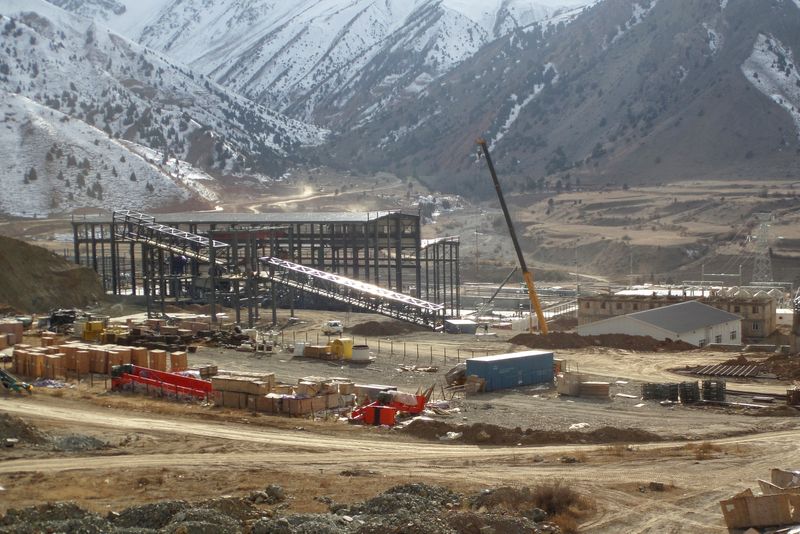Explainer-What is antimony and why is China curbing its exports?
2024.08.16 07:11
(Reuters) – China will impose export controls on some antimony products from Sept. 15, it said on Thursday, citing national security, adding to measures imposed by Beijing since last year to curb shipments of strategic minerals.
Following are details on Chinese restrictions and the antimony market.
WHAT IS ANTIMONY AND WHAT IS IT USED FOR?
Antimony is a shiny grey metalloid known since ancient times when it was used in medicine and cosmetics.
Its biggest application today is as a flame retardant, which accounted for around half of global usage in 2023, according to brokerage CICC.
At the same time, about a fifth of antimony was used to make photovoltaic glass to improve the performance of solar cells. Most of the rest was used in lead-acid batteries.
Antimony has also become increasingly strategic because of its use in military equipment, such as infrared missiles, nuclear weapons and night vision goggles, and as a hardening agent for bullets and tanks.
The most commonly mined ore is called stibnite, which contains antimony and sulphur. Antimony can also be a byproduct of gold mining, or recovered from recycling lead-acid batteries.
WHAT ARE CHINA’S RESTRICTIONS?
China’s new limits apply to antimony products including ore, ingots and oxide.
Exporters must apply for licences for dual-use items and technologies – those with potential military as well as civilian applications, a process that typically takes two to three months in China.
The rules also prohibit the export of gold-antimony smelting and separation technology without permission.
There are no limits on volume, but on the basis of previous curbs, antimony exports are likely to drop after the restrictions are enforced.
Chinese exports of gallium and germanium, under similar restrictions since last year, fell as some Chinese exporters could not secure licences and some overseas buyers did not want to disclose the ultimate purpose of usage as required under the new rule, industry sources have said.
WHAT IS CHINA’S ROLE IN THE ANTIMONY MARKET?
China is the largest producer of antimony, accounting for 48% of mine production in 2023, followed by Tajikistan at 25%, U.S. Geological Survey (USGS) data showed.
In China, antimony reserves are concentrated in Guangxi, Hunan and Gansu provinces.
China is also the biggest producer of processed antimony, including antimony trioxide (ATO), which is traditionally used in flame retardants and increasingly as a clarifying agent in solar glass.
Consultancy Project Blue said China had also been the biggest exporter of antimony ingots, with purity above 99%, but as Chinese production of solar cells has surged, more ingot is consumed domestically.
China’s exports of unwrought antimony, including ingot, fell 45% year-on-year in the first half of 2024 to 1,694 metric tons, customs data showed.
In response, European ATO refiners looked to Tajikistan, Vietnam, and Myanmar as alternatives, with U.S. buyers mostly sourcing materials from India, Project Blue said.
WHY IS ANTIMONY SUPPLY SO TIGHT?
Known antimony reserves can meet demand for about 24 years, far less than known reserves of rare earths, lithium and other metals, though slightly more than for silver, USGS data showed.
China is the biggest antimony ore producer but production has declined to 40,000 tons in 2023 from 61,000 tons in 2020 as a result of falling ore grades and more stringent environmental requirements.
Despite its dominance in ore output, China is a net importer of antimony concentrates and depends on ore from countries including Thailand, Myanmar and Russia.
Russia was once a major antimony concentrate exporter to China, but its supply fell sharply this year as major producer Polyus’ output declined. Export duty and mineral extraction tax also made shipping the material overseas less attractive.
“There is no pipeline of supply to turn on,” said Christopher Ecclestone, a principal and mining strategist at Hallgarten & Company in London.
China has accounted for more than 70% of ATO production globally since 2022, said Project Blue.
Outside China, processing capacity is limited.
Perpetua Resources, which is building a U.S. antimony and gold project with support from the Pentagon, had planned to begin production by 2028, but is studying ways to produce antimony faster in response to the Chinese curbs.
The market is also tight because of increased demand from the solar and military sectors, with a deficit estimated at 10,000 tons in May by Project Blue. The shortfall could widen after the latest Chinese restrictions.
IMPACT ON PRICES
Antimony prices have already hit record highs.
Chinese antimony, CIF Northwestern (NASDAQ:) Europe and of 99.65% purity, traded at all-time highs above $22,000 a metric ton by the end of July, LSEG Workspace data showed.
In China, antimony, of 99.91% purity, has traded at a record 162,500 yuan ($22,657.24) a ton since Wednesday, Shanghai Metal Exchange data showed.
Industry analysts say prices could climb another $8,000 a ton this year to $30,000, as ex-China buyers seek to stockpile more material because of the new restriction.

Share prices of antimony producers in China jumped by up to 10% on Friday.
Shares of Perpetua surged nearly 24% to their highest in more than three years on Thursday.








